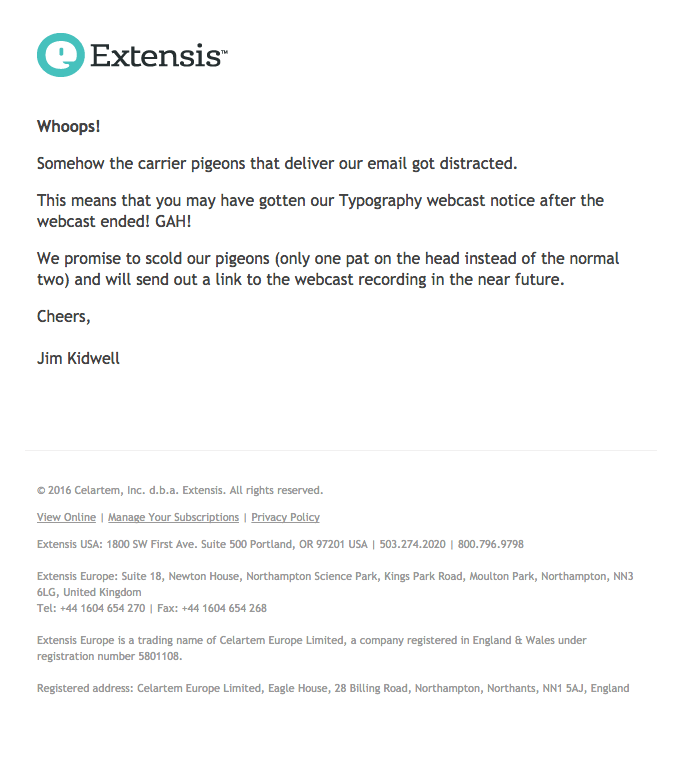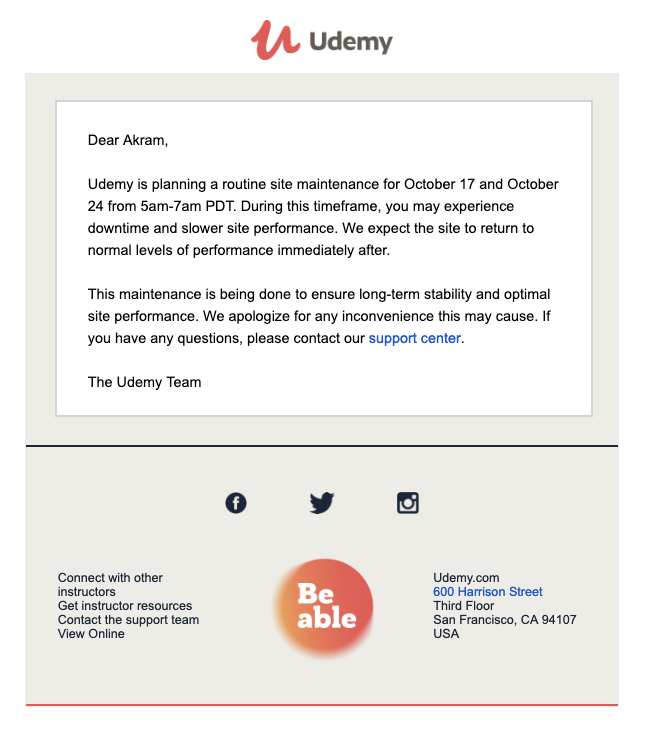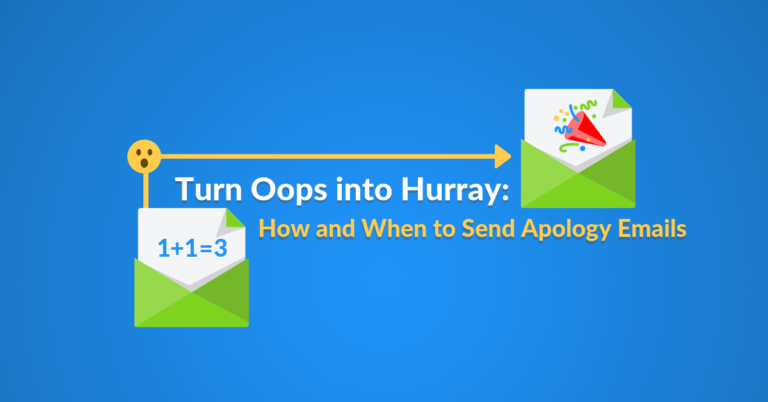Making mistakes is something we’re all good at.
But what to do when you screw up an email?
We’ve put together a simple risk management and crisis response list for you in case of emergencies. It’s important to remember that how you react matters. No business is perfect, and mistakes do happen.
We’ve put together this article in which you’ll find:
- What is an apology email
- How to Apologize in an email
- 5 tips to keep your apology email positive
- When not to send an apology email
- Apology email subject line examples
- 7 correction email examples
By the end of the article, you’ll be an expert in the art of the correction email.
What is an Apology Email?
An apology email is a message you send when something goes wrong in your previous email. It is your chance to make it up to your contacts and keep a healthy, sustainable customer relationship.
Sometimes, the mistakes are minor, like forgetting to include an attachment in an email to a teammate or partner.

To fix it, you can hit “reply” again and add the attachment like you (and I) have done dozens of times before and never give another thought to it.
Sometimes, the mistakes are more serious, like sending an email blast to 60K contacts with:
- A wrong time-sensitive offer
- An unedited version of an email
- An email with a broken link
In these instances, where confusion could cause damage to your:
- Brand,
- Business,
- And your personal reputation.
It’s important to address the situation, correct the record, and own the mistake.
Like everyone, we make mistakes, and we also tend to be forgiving when someone apologizes.
How to Apologize to a Customer in an Email Letter
There are primary steps to follow when writing a correction email to a customer.
1. Diagnose the mistake
As a doctor, look at the entire situation from various angles to identify and assess the nature of the damage.
It’s crucial during this stage to think because there may be related issues that spawn from a single mistake.
For example, accepting orders for a discounted product to be supplied by a third-party vendor can impact the supply chain. Thus, it’s important to connect the dots wherever they may be to assess and diagnose the issue.

2. Label its severity
Once you have a list in hand, attach a level of seriousness to each issue identified. Not all mistakes are equal.
It’s important during this stage not to sugarcoat the mistake or to attach too much importance to more trivial ones. Be honest regardless of where the mistake falls on the spectrum.
It’s critical to understand how big of an impact a mistake has before beginning an apology email response process.
Consider grouping mistakes into one of the following categories:
- Minor issues, typos, imperfections: Things that won’t hurt the business or the customer. These are not likely to require a response but should have action taken to reduce and prevent them in the future.
- Embarrassing mistakes: Technical errors that impede the customer experience, but can be resolved.
- Detrimental mistakes: Blunders like this can cause harm by negatively impacting the customer experience, business sales, and reputation.
- Real problems: These issues can hurt an organization’s revenue and reputation and cause long-term damage to its customers.
Once you have completed the first two steps, it’s time to craft your apology email response as recommended in the following section.
3. Creating apology emails
As with any marketing campaign, it’s essential to first lay out the strategy for how to best approach creating and delivering an apology.
Own the mistake
The saying goes: “You can run but you can’t hide.” Never has one said a more brutal truth when it comes to owning up to a mistake.
Sure, you can bluster and babble your way through an issue in the hopes of deflecting blame onto someone else. The reality is deflections and excuses compound the issue at hand.
Those on the receiving end of the mistake care less about you laying blame elsewhere than you fixing the issue for them.
So the best practice advice is to forget about playing your own defense attorney and ask for mercy before your court of contacts.

Saying you’re sorry goes a long way
In conjunction with owning your mistake, it’s important to articulate that you are sorry.
Don’t dance around and avoid using the phrase because it looks like you’re trying to find an easy way out.
Again, humans make mistakes and are often quite forgiving when people admit they were wrong and are sorry for it. So, say you’re sorry. And mean it.
Respect their feelings
Never underestimate the importance of authenticity when it comes to owning your mistake and saying you’re sorry.
Customers and prospects can sniff out insincerity from a billion miles away. It’s critical that you don’t forget this element in the tone and tenor you set in your apology letter.
Again, it’s important to reinforce the importance of thinking outside of yourself. Put yourself in the recipient’s shoes to understand how they are feeling and acknowledge that.
The absolute worst tact to take Is an inward-focused, “woe is me” approach. In other words, think about “them” and not you.

Show empathy
Often the best way to think about them and not you is to restate or assume what it is that they are thinking or feeling.
By showing empathy, you will appear:
- Thoughtful,
- Reflective,
- And sincere.
Present a simple explanation for what you think or know went wrong.
When expressing empathy, make sure to write an email that connects on a personal level.
Express how you’ll fix the issue going forward
Sometimes it makes sense immediately after demonstrating empathy to explain what you intend to do. It prevents such mistakes from happening in the future.
This is not always called for in all instances but can often go a long way toward repairing a bruised relationship. Sometimes asking a simple question can go a long way, such as: what else can I do to help repair our relationship?
Again, this is not required in all instances. You should take care to assess whether the answers to that question will start a Tidal Wave of unintended consequences or not.

Ask for forgiveness
Unless it will make a recipient feel uncomfortable, it’s fine to ask for forgiveness. Don’t belabor the point and drone on with self-flagellation messages.
Again, remember that we are all human and that each of us makes mistakes from time to time. When this happens, asking for forgiveness is not only natural but might also be expected.
So, swallow your pride after owning your mistake and ask for forgiveness.
Don’t take it personally
Owning a mistake is not the same thing as an assault on your character.
You should try to be sincere without becoming weak and internalize the mistake. Even if someone expresses anger, it’s important to keep a measured distance from its most caustic elements.
In other words, don’t beat yourself up.
Keep it simple
If Abraham Lincoln can consecrate the Gettysburg war memorial in 272 words, you can own and accept a mistake in far fewer words.
- Keep it simple
- Be brief
- Be straightforward
- Don’t beat around the bush
5 Tips to Keep Your Apology Email Positive
1. Avoid negative words in your subject line
You shouldn’t be sending emails with subject lines that recipients feel like avoiding.
Avoid words like “I’m sorry” or “Please forgive me.”
Instead, try to frame the email subject line in a way that motivates recipients to open it.
Bad subject line example: I’m deeply sorry, let’s fix this
Good subject line example: Retraction on our previous email
Own your mistake as I mentioned above at the start of the article, don’t hide from it. Keep your subject line light so recipients open your email, and own your mistake in the email copy.
2. Avoid extreme adjectives
Extreme adjectives such as “deeply sorry” or “terribly embarrassed” can have the opposite effect.
Instead of using these words, frame your apology email in a positive light by explaining what you did right and why recipients should be happy to know this information.
Bad phrase example: “We are terribly embarrassed that we’ve referred to…”
Good phrase example: “We’re reaching out to correct an error from our previous email…”
Here’s the takeaway.
There’s no need to give away all your secrets or emotions.
Don’t say: “I made a mistake in my previous email”
Instead, try: “In our last email we may have given the wrong impression…”
This tip helps make it clear that you’re not trying to hide anything and is more likely to elicit forgiveness when done correctly.
3. Avoid negative terms
This is a tip that applies to all your communication not just your apology emails.
Negative terms scare off your audience or create a negative connotation.
You don’t want to sound like you’re making excuses or being defensive because it will make your apology less sincere and more likely to be rejected.
If you can, try using a different word that has a positive connotation instead of the term with a negative meaning.
For example, “mistake” could become “error”.
Here are some negative terms to avoid in your apology email
- Uncertain
- Fear
- Problems
- Unfortunate
- Bad
- Failure
- Trouble
To illustrate this in a real-life case, here are 2 examples.
| Negative example: | Positive example: |
| “The problem we have at hand is that the link we shared in our previous email is broken which caused your orders to fail. We’re unable to fix this problem before the end of the week. We’re deeply sorry.” | “The situation we have at hand is that the link we sent you in our previous email is broken which means your orders may not have made it through. Our tech team is working on fixing it so you’ll be able to place your orders by the end of the week. Thanks for understanding.” |
Do you see the difference?
4. No blame game
You don’t have to point fingers at anyone in your apology email. Blaming others can only make the situation worse.
You should never say anything that blames an individual or group.
It would sound like “we lost because our team was not good enough.” No one wants to hear that.
Your apology email should be about how you will resolve a situation, not what someone else has done to cause the mistake.
5. Add a pinch of humor
A way to keep your email upbeat is to use humor.
If it’s appropriate, even light-hearted sarcasm could work well as long as it’s not offensive.
This could be done by making a joke about the situation or referencing something you both know of that can have some humor in it.
Humor is one way to alleviate any tension your email could potentially cause, and people will appreciate hearing from someone who has a good sense of what makes them laugh.
Humor makes your apology email seem less negative.
It can lighten the mood and provide a sense of relief for both you and the receiver.
To see how brands used humor in their apology emails, check the examples included below in this article.
You don’t always have to apologize in an email. It depends on the situation.
Let’s see 4 cases on which you DON’T need to send an apology email to customers.
When Not to Send an Apology Email to a Customer
A strategy is defined as what you decide to do and what you decide not to do.
As important as knowing when to send an apology or correction email, it’s also important to know when not to send an apology or correction email.
1. When you make typo mistakes
Everyone makes spelling and grammar mistakes from time to time, so it’s not important to send a correction email and further clog someone’s inbox.
Just chalk up the lesson to the importance of proofreading and do your best to avoid that situation in the future.
2. When you accidentally send the same email twice
Sometimes even the most earnest of fail-safe methods fail to prevent mistakes.
Even with advanced email marketing automation platforms these days. It’s still possible that you will send the same email twice to the same contacts.
If this happens, it’s important not to compound the error by adding a third email into the inbox to say “sorry.” Let the error alone and make a note to include a basic apology in the next scheduled email.
3. When you send the wrong coupon or promo code
Sometimes you can fix mistakes by amending a back-end platform than by admitting the error to those recipients.
For example, if you accidentally send the wrong coupon or promotional code to your contact database. Update the back end with the incorrect code so you can capture those sales. In basketball, the saying is: “No harm, no foul.”
In the world of email marketing and campaigns, it’s not a mistake if no one is there to recognize it and call you on it.

4. When you include a broken link
As with a wrong coupon or promotional code, the inclusion of a broken link in an email can be fixed on the back end through a simple redirect to the correct URL.
Again, if at all possible don’t compound an error by flooding your contact database inboxes with unnecessary or extraneous apologies when a simple back-end fix is possible.
In some cases, it won’t be possible to fix a wrong link with a redirect.
For example, if you’ve sent an email with a link to another page on your site, a redirect would affect all the traffic, not only the traffic coming from your email campaign.
9 “Oops!” (Apology) Email Subject Line Examples
Your email subject line is the first thing that your subscribers will see in their notification and inbox. Make it clear that it is an apology email so they would open it and learn about what went wrong and what you are apologizing for.
Get inspired by these examples:
- My bad: Link fixed
- Whoops, let’s make it up for you
- Something went wrong today
- We apologize
- Sorry we sent the wrong link
- An apology from us
- We were wrong. Here’s what happened.
- We’re working on it.
- App Downtime Apology
Experiment using emojis in the subject line. That might help your emails to stand out in your subscriber’s inbox.
The Subject Line Tester by Automizy can provide you a helping hand, by grading your subject lines based on data from over 1 million campaigns.
The tool also provides subject line templates you can use to increase your email open rates.
7 Apology Email Examples
If you decide to send a correction email campaign, you can do it similarly as you do a bulk email campaign.
At this stage, you might need to come up with the design for your apology email template.
Get inspired by the following examples that took a creative, light approach to respond to a mistake.
1. Use brand-relatable content – Friendly’s
The correction email template example shows you how to recover from an email mistake. With a funny title and image displayed, it emphasizes the fact that something went wrong.

2. Oops! Offer a discount – Bumble And Bumble
Website down! That is something we all went through at some point.
What if your website goes down? Follow this practice and send a correction email to your contacts when your website goes through a little hiccup, as Bumble And Bumble did.
The copy tones down the problem, for example, “our site had a little hiccup”.
Also, the “Boo-Boo” is creative. It’s smart branding as the logo is Bb, they stick to the same letter to match their brand name and identity.

3. Admit if something goes wrong and offer special discount code – Moosejaw
Few things are as disarming as humor. We found the following humorous example as one to emulate. Not only does it follow the prescribed course for sending a correction email, but it does so in a creative way that turns a negative into a positive.

4. Respect your subscribers – FilterEasy
Subject line: Oops: Someone Hadn’t Had Their Coffee Yet This Morning
This oops email template example that FilterEasy sent to their subscribers apologizing for sending an email quiet early morning.
Obviously, FilterEasy has a certain respect for subscribers’ sleeping hours.

5. Point out what went wrong – Extensis
Subject line: Whoops! RE: HOW Designcast Today: Typography – What’s Hot, What’s Not.
The mistake was that Extensis sent a webcast notice again after the webcast ended. They sent the following apology email.

Also, they notified their contacts that they would receive an email with the recorded webinar. That is a good strategy for webinar email marketing.
6. Apologize for contacts’ confusion – FrameBridge
FrameBridge made a mistake when setting up the target contacts they want to send a re-engagement email to.
By mistake, they included their loyal customers in an email asking if contacts want to be removed from their email list. Oops!

This email example illustrates how you can use humor smartly. Not too cheesy or cringy, but funny enough to give the email a positive feeling.
7. Inform in advance – Udemy
Udemy does a stunning job with this simple apology email.
They are not apologizing for something that already went wrong. They are informing their subscribers about planned website maintenance and apologizing in advance.

Conclusion
At one point, you might make a mistake.
Not addressing your oops moment would leave your subscribers annoyed and even talking about it to the next person they see.
Sending apology emails is not on anyone’s wish list. But doing so doesn’t have to be the end of the world.
In some cases, apology emails can be turned into a positive affirmation of your brand and company.
Remember to think like the recipient rather than the sender. This level of empathy will help guide your apology email strategy.

